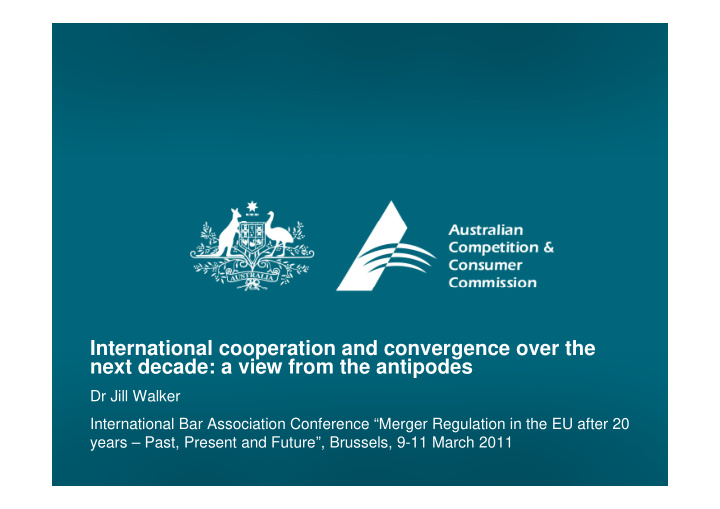



International cooperation and convergence over the next decade: a view from the antipodes Dr Jill Walker International Bar Association Conference “Merger Regulation in the EU after 20 years – Past, Present and Future”, Brussels, 9-11 March 2011
Outline • Merger regulation and review in Australia • Procedural coordination • Coordination on substantive issues • Convergence
Merger Regulation in Australia • Test for mergers which breach s.50 of the Competition and Consumer Act is where “… the acquisition would have the effect, or be likely to have the effect, of substantially lessening competition in a market” (since 1992) • Court based v administrative system • Limited litigation: AGL v ACCC only completed litigation and judicial decision
Merger Review • Voluntary notification to the ACCC • Informal v formal clearance process • s.87B provides for court enforceable undertakings (=remedies) • Authorisation available from the Australian Competition Tribunal where offsetting public benefits
Relevant characteristics • Small market: fewer players; distribution v manufacturing • Geographic isolation: import competition may be limited • Voluntary notification creates some unique issues for Australia (procedural and substantive)
Procedural coordination: challenges Procedural coordination: challenges • Parties often focus efforts on larger jurisdictions where parent companies located and notification is mandatory • Late notification can result in pressure on smaller countries to complete reviews in unrealistic timeframes • Generally high level of notification and cooperation from Australian business and advisory community but can get forgotten in a global context • Australia manages this risk by intelligence gathering and communicating with other agencies • Cooperation protocol with NZCC
Procedural coordination: information sharing Procedural coordination: information sharing • Standard form confidentiality waiver since 2009 • Reduced time spent negotiating terms of waiver • Early waiver can assist agencies to share preliminary views on markets and potential theories of harm etc. • Example: in BHP/Rio Tinto proposed JV the EC provided help to the ACCC in forwarding requests for information to third parties
Substantive coordination • Understanding market characteristics and identifying competition issues • Remedies: ensuring consistency and effectiveness • Examples – Pfizer/Wyeth – Agilent/Varian
Substantive coordination: Pfizer/Wyeth • Global merger with Australian subsidiaries • ACCC review followed global announcement • Multiple animal & human vaccines and pharmaceuticals • Australian operations included some local manufacturing and importation/distribution • Competition problems identified in various markets for animal health products in Australia • Extensive consultation and coordination with EC and FTC on issues and remedies
Substantive coordination: Pfizer/Wyeth • Remedy provided to the ACCC coordinated and consistent with the FTC • Divestiture of companion animal vaccines business to Boehringer Ingelheim Vetmedica Inc (BI) in US and Australia: critical for maintaining effective competition via imports by a company with broader local presence • Divestiture of livestock vaccines and pharmaceuticals business to a purchaser to be approved at a later date (Verbac) included Fort Dodge (Wyeth) single manufacturing facility in Australia as well as IP and biological materials, e.g. master seeds
Substantive coordination: Agilent/Varian • Global merger of companies headquarters in the USA • Australia was not notified, picked up from complaint • Various markets for chromatographs and mass spectrometers (bio-analytical measurement) • Agilent had no R&D or manufacturing in Australia, but supplied imported products and associated before and after sales customer services • Varian had limited R&D and manufacturing (one market) • Parties were each others closest competitors & merger would result in significant concentration in Australia
Substantive coordination: Agilent/Varian • EC had identified competition issues in the same product markets as Australia and required divestiture • ACCC accepted a s.87B remedy to: – comply with the EC divestiture requirements – submit to Federal Court of Australia jurisdiction – seek ACCC approval of the proposed purchasers • ACCC approved Inficon and Bruker as proposed purchasers ahead of EC or FTC but provided for approval of alternative purchasers • Coordinated remedy critical for maintenance of effective competition from established industry participants
Convergence • ACCC is an active participant in ICN and OECD • 2008 revised Merger Guidelines had regard to ICN recommended practices and the analytical guidelines of other jurisdictions • Convergence with NZ (trans-Tasman market): – essentially the same substantive test – cooperation protocol – cross appointments
Closing remarks • Australia is a small and remote market • Can be “forgotten” by HQ in global merger notifications, especially with voluntary notification • Global mergers can have significant impacts on Australian markets • Coordination of remedies is critical to maintaining effective competition in Australia • Australia has benefited greatly from cooperation with the EC & US and we look forward to continuing coordination
www.accc.gov.au
Recommend
More recommend